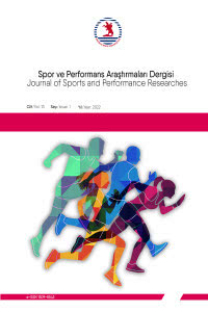DENGE DİSKİ EGZERSİZLERİNİN DİNAMİK DENGE VE DURUŞ KONTROLÜ ÜZERİNDEKİ ETKİSİNİN İNCELENMESİ
Çoklu tek-bacak sıçrama denge testi, denge, hamle testi, yıldız denge testi
THE INVESTIGATION OF EFFECT OF BALANCE DISC EXERCISE ON DYNAMIC BALANCE AND POSTURAL CONTROL
___
- Tippett SR, Voight ML. Functional Progressions for Sport Rehabilitation. Human Kinetics; 1995.
- Grigg P. Peripheral neural mechanisms in proprioception. Journal Sport Rehabilitation. 1994; 3, 2–17.
- Palmieri RM, Ingersoll CD, Stone MB, Krause BA. Center-of-pressure parameters used in the assessment of postural control. J Sport Rehabil. 2002; 11:51–66.
- Bressel E, Yonker JC, Kras J, Heath EM. Comparison of Static and Dynamic Balance in Female Collegiate Soccer, Basketball, and Gymnastics Athletes. Journal of Athletic Training. 2007; 42(1):42–46.
- Filipa A, Byrnes R, Paterno MV, Myer GD, Hewett TE. Neuromuscular Training Improves performance on the star excursion balance test in young female athletes. Journal of Orthopaedic & Sports Physical Therapy. 2010; 40(9):551-558.
- McKeon PO, Ingersoll CD, Kerrigan DC, Saliba E, Bennett BC, Hertel J. Balance training improves function and postural control in those with chronic ankle instability. Medicine &Science in Sports & Exercise.2008; 40(10):1810-1819.
- Valovich McLeod TC, Armstong T, Miller M, Sauers JL. Balance improvements in female high school basketball players after a 6-week neuromuscular- training program. Journal of Rehabilitation.2009; 18:465-481.
- Khodabakhshi M, Javaheri SAH, Atri AE, Zandi M, Khanzadeh R. The effect of balancing and resistive selected exercise on young footballers’ dynamic balance. European Journal Sports and exercise science. 2012; 1(3):44-51.
- Hoch MC, Staton GS, McKeon PO. Dorsiflexion range of motion significantly influences dynamic balance. Journal of Science and Medicine in Sport. 2011; 14; 90-92.
- Shimada H, Uchiyama Y, Kakurai S. Specific effects of balance and gait exercises on physical function among the frail elderly. Clinical Rehabilitation.2003; 17: 472–479.
- Madras, D. and Barr JB. Rehabilitation for functional ankle instability. Journal of Sport Rehabilitation. 2003; 12 (2): 133-142.
- Verhagen E, Van Der Beek A, Twisk J, Bouter L,Bahr R, Van Mechelen W. The Effect of a Proprioceptive Balance Board Training Program for the Prevention of Ankle Sprains: A Prospective Controlled Trial. The American Journal of Sports Medicine. 2004; 32(6):1385-1393.
- Reiman Micheal P, Manske Robert C. Functional testing in human performance,139 tests for sports, fıtness, and occupational settings. Human Kinetics.2009; 108-116.
- Aggarwal A, Zutshi K, Munjal J, Kumar S, Sharma V. Comparing stabilization training with balance training in recreationally active individuals. International Journal of Therapy & Rehabilitation. 2010; 17 (5):244-253.
- Crill MT, Kolba CP, Chleboun GS. Using lunge measurements for baseline fitness testing. Journal of Sport Rehabilitation.2004; 13:44-53.
- Iatridou K, Mandalidis D, Chronopoulos E, Vagenas G,
- Athanasopoulos S. Static and dynamic body balance following provocation of the visual and vestibular systems in females with and without joint hypermobility syndrome. Journal of Bodywork & Movement Therapies. 2013; 1-6.
- Ferrell WR, Tennant N, Baxendale RH, Kusel M, Sturrock RD. Musculoskeletal reflex function in the joint hypermobility syndrome. Arthritis Care & Research. 2007; 57:1329-1333.
- Smart LJ, Smith DL. Postural Dynamics: clinical and empirical implications. Journal of Manipulative Physiological Therapeutics.2001; 24:340-348.
- Kovac EJ, Birmingham TB, Forwell L, Litchfield RB. Effect of training on postural control in figure skaters. Clin J Sport Med 2004; 14:215-224.
- Riemann BL,Tray NC, Lephart SM. Unilateral multiaxial coordination training and ankle kinesthesia,muscle strength,and postural control. J Sport Rehabil. 2003; 12:13-30.
- Puls A, Gribble PA. Comparison of two thera-band training rehabilitation protocols on postural control. J Sport Rehabil. 2007; 16:75-84.
- Kahle NL, Gribble PA. Core stability training in dynamic balance testing among young, healthy adults. Athl Train Sports Health Care. 2009; 1(2):65–73.
- Eisen TC, Danoff JV, Leone JE, Miller TA. The effects of multiaxial and uniaxial unstable surface balance training in college athletes. The Journal of Strength &Condition Reserarch. 2010; 24(7):1740–1745.
- Gribble PA and Hertel J. Considerations for Normalizing Measures of the Star Excursion Balance Test. Measurement in Physical Education and Exercise Science. 2003; 7(2): 89–100.
- ISSN: 1309-5110
- Yayın Aralığı: Yılda 3 Sayı
- Başlangıç: 2010
- Yayıncı: Ondokuz Mayıs Üniversitesi Yaşar Doğu Spor Bilimleri Fakültesi
SPORCU VE SEDANTERLERDE Q AÇISI İLE BAZI FİZİKSEL ÖZELLİKLER ARASINDAKİ İLİŞKİNİN İNCELENMESİ
MURAT ELİÖZ, TÜLİN ATAN, AJLAN SAÇ, BADE YAMAK
DOI No: 10.17155/spd.18840 ÜNİVERSİTE ÖĞRENCİLERİNİN YALNIZLIK DÜZEYLERİ ÜZERİNE SPORUN ETKİSİ*
İLKNUR YAZICILAR ÖZÇELİK, RESUL ÇEKİN, OSMAN İMAMOĞLU, SEBİHA GÖLÜNÜK BAŞPINAR
Ali TEKİN, Gülcan TEKİN, Melih ÇALIŞIR, Serdar BAYRAKDAROĞLU
MUĞLA SÜPER AMATÖR LİGİNDEKİ FUTBOLCULARIN SALDIRGANLIK DÜZEYLERİNİN İNCELENMESİ
YAKUP AKİF AFYON, Sabri Can METİN
FUTBOL TARAFTARI FANATİKLİK ÖLÇEĞİ*
Mehmet Yalçın TAŞMEKTEPLİGİL, SONER ÇANKAYA, TANER TUNÇ
ÜNİVERSİTE ÖĞRENCİLERİNİN BESLENME ALIŞKANLIKLARININ İNCELENMESİ: ONDOKUZ MAYIS ÜNİVERSİTESİ ÖRNEĞİ
Egemen ERMİŞ, Erol DOĞAN, Necati Alp ERİLLİ, ARif SATICI
ÜNİVERSİTE ÖĞRENCİLERİNİN YALNIZLIK DÜZEYLERİ ÜZERİNE SPORUN ETKİSİ
İlknur YAZICILAR ÖZÇELİK, Osman İMAMOĞLU, Resul ÇEKİN, Sebiha GÖLÜNÜK BAŞPINAR
DENGE DİSKİ EGZERSİZLERİNİN DİNAMİK DENGE VE DURUŞ KONTROLÜ ÜZERİNDEKİ ETKİSİNİN İNCELENMESİ
Gülşah ŞAHİN, Adnan ÇADIR, Hikmet ŞEKER, Melike YEŞİLIRMAK
ALİ TEKİN, GÜLCAN TEKİN, Bahadır ALTAY, MELİH ÇALIŞIR, SERDAR BAYRAKDAROĞLU
